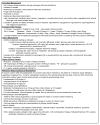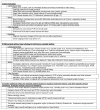Status epilepticus and refractory status epilepticus management
- PMID: 25727508
- PMCID: PMC4346709
- DOI: 10.1016/j.spen.2014.12.006
Status epilepticus and refractory status epilepticus management
Abstract
Status epilepticus (SE) describes persistent or recurring seizures without a return to baseline mental status and is a common neurologic emergency. SE can occur in the context of epilepsy or may be symptomatic of a wide range of underlying etiologies. The clinician's aim is to rapidly institute care that simultaneously stabilizes the patient medically, identifies and manages any precipitant conditions, and terminates seizures. Seizure management involves "emergent" treatment with benzodiazepines followed by "urgent" therapy with other antiseizure medications. If seizures persist, then refractory SE is diagnosed and management options include additional antiseizure medications or infusions of midazolam or pentobarbital. This article reviews the management of pediatric SE and refractory SE.
Copyright © 2014 Elsevier Inc. All rights reserved.
Figures
References
-
- Chin RF, Neville BG, Peckham C, Bedford H, Wade A, Scott RC. Incidence, cause, and short-term outcome of convulsive status epilepticus in childhood: prospective population-based study. Lancet. 2006;368:222–9. - PubMed
-
- Commission on Epidemiology and Prognosis. International League Against Epilepsy: Guidelines for epidemiologic studies on epilepsy. Epilepsia. 1993;34:592–6. - PubMed
-
- Shinnar S, Berg AT, Moshe SL, Shinnar R. How long do new-onset seizures in children last? Ann Neurol. 2001;49:659–64. - PubMed
-
- Brophy GM, Bell R, Claassen J, et al. Guidelines for the evaluation and management of status epilepticus. Neurocrit Care. 2012;17:3–23. - PubMed
-
- Tobias JD, Berkenbosch JW. Management of status epilepticus in infants and children prior to pediatric ICU admission: deviations from the current guidelines. South Med J. 2008;101:268–72. - PubMed
Publication types
MeSH terms
Substances
Grants and funding
- K23-NS075363/NS/NINDS NIH HHS/United States
- K23-NS076550/NS/NINDS NIH HHS/United States
- T32 NS007413/NS/NINDS NIH HHS/United States
- K23 NS075363/NS/NINDS NIH HHS/United States
- 1R01NS053998/NS/NINDS NIH HHS/United States
- K12-NS049453/NS/NINDS NIH HHS/United States
- K12 NS049453/NS/NINDS NIH HHS/United States
- 2U01NS045911/NS/NINDS NIH HHS/United States
- K23 NS076550/NS/NINDS NIH HHS/United States
- U01NS077276/NS/NINDS NIH HHS/United States
- U01 NS045911/NS/NINDS NIH HHS/United States
- T32 NS061779/NS/NINDS NIH HHS/United States
- U01 NS053998/NS/NINDS NIH HHS/United States
- R01 LM011124/LM/NLM NIH HHS/United States
- U01 NS077276/NS/NINDS NIH HHS/United States
- 1R01LM011124/LM/NLM NIH HHS/United States
LinkOut - more resources
Full Text Sources
Other Literature Sources



